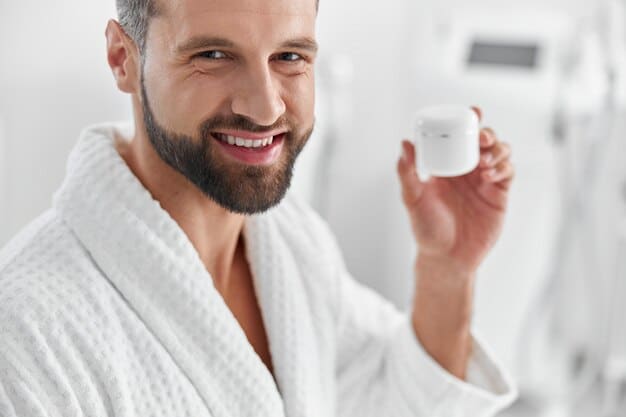The Truth About Men’s Skincare: Debunking 7 Costly Myths

Many men unknowingly subscribe to common skincare myths that not only compromise their skin health but also lead to unnecessary expenses on ineffective products, highlighting the importance of understanding evidence-based practices for truly beneficial results.
Navigating the world of skincare can feel overwhelming, especially with an abundance of conflicting information. For men, this landscape is often complicated by stubborn myths that persist despite advancements in dermatological science. This article aims to expose the reality behind these misconceptions, offering practical, evidence-based insights that will not only improve your skin but also save your wallet. Dive into the truth about men’s skincare: debunking 7 common myths that cost you money.
understanding men’s skin: beyond the surface
For too long, the narrative around men’s skincare has been simplistic, often assuming that a bar of soap and water is sufficient. However, understanding the unique biological characteristics of male skin is the first step toward effective care. While the basic structure of skin is similar across genders, men’s skin does present distinct differences that influence how it should be treated.
Testosterone plays a significant role in differentiating male skin. This hormone leads to increased sebum production, resulting in oilier skin with larger pores compared to women’s. This predisposition to oiliness often translates to a higher likelihood of acne and blackheads, particularly during adolescence and young adulthood. The larger pores can also be more noticeable, prompting a desire for solutions that address these concerns.
The thickness of male skin
Another key difference is skin thickness. Men’s skin is roughly 20-25% thicker due to a higher collagen density. This greater thickness can make it more resilient to certain external aggressors but also means that products designed for women, which might be formulated for thinner, more delicate skin, may not penetrate or perform as effectively on men’s skin. This isn’t to say male-specific products are always necessary, but rather that potency and ingredient selection should be considered.
- Increased collagen density contributes to thicker skin.
- Higher sebum production leads to oilier skin and larger pores.
- More pronounced facial hair growth impacts daily skin routines.
Furthermore, daily shaving introduces a unique set of challenges. Shaving can cause micro-abrasions, redness, and irritation, increasing the skin’s sensitivity and vulnerability to bacterial infections. Proper shaving techniques and suitable pre- and post-shave products become crucial components of a man’s skincare regimen, addressing immediate irritation and preventing long-term damage.
Recognizing these fundamental differences allows us to move beyond generic advice and tailor skincare practices to genuinely benefit men’s skin. It’s about being informed, not just about marketing, but about the science that underpins effective skincare. Only by understanding these basics can we truly debunk the myths that follow.
Myth 1: “soap is good enough for your face”
This is arguably one of the most pervasive and damaging myths in men’s skincare. The idea that a regular bar of soap, often designed for the body, is suitable for facial cleansing is a relic of outdated grooming habits. While it might feel convenient, body soaps are formulated differently and can do more harm than good for the delicate facial skin.
Most body soaps are highly alkaline, meaning they have a high pH level. Our skin, by contrast, is naturally acidic, with a pH usually between 4.5 and 5.5. This slightly acidic environment, known as the “acid mantle,” is crucial for protecting the skin against bacteria, pollution, and moisture loss. When you use an alkaline soap on your face, you disrupt this protective barrier.
The consequences of harsh cleansers
Disrupting the acid mantle can lead to a cascade of problems. Initially, your skin might feel “squeaky clean” and tight, which some misguidedly interpret as a sign of effective cleansing. In reality, it’s often a sign of stripped natural oils and compromised barrier function. This can result in increased dryness, irritation, and even paradoxically, increased oil production as your skin tries to compensate for the lost moisture.
- Alkaline soaps strip the skin’s natural protective barrier.
- Can lead to dryness, irritation, and sensitivity.
- May trigger a rebound effect, increasing oil production.
Washing your face with harsh soap can exacerbate existing skin conditions, making acne worse by irritating inflamed lesions, and causing sensitive skin to react with redness and stinging. For anyone prone to razor burn or ingrown hairs, a compromised skin barrier only makes these issues more likely and more severe. Investing in a dedicated facial cleanser, one that is pH-balanced and gentle, is a foundational step in any effective skincare routine, regardless of gender.
Facial cleansers are specifically formulated to gently remove impurities, excess oil, and pollutants without stripping the skin’s essential moisture. They often contain beneficial ingredients like humectants (e.g., glycerin) to attract water to the skin or soothing agents (e.g., aloe vera, chamomile) to calm irritation. Choosing the right cleanser sets the stage for all other products to work effectively, preventing issues rather than creating them.
myth 2: “moisturizer is only for dry skin”
This myth is perpetuated by a misunderstanding of what moisturizers actually do. Many men, especially those with oily or combination skin, believe that applying moisturizer will only make their skin greasier or lead to breakouts. This couldn’t be further from the truth. Moisturizers are essential for all skin types, serving a fundamental role in maintaining skin health and barrier function.
At its core, moisturizing is about maintaining the skin’s hydration levels and reinforcing its protective barrier. Our skin constantly loses moisture through a process called transepidermal water loss (TEWL). Environmental factors, such as harsh weather, air conditioning, and even hot showers, can accelerate this loss. A good moisturizer helps to trap water in the skin, preventing excessive TEWL and keeping the skin supple and healthy.
Benefits for oily and acne-prone skin
For oily or acne-prone skin, moisturizing is particularly crucial but often overlooked. When oily skin is stripped of moisture (for example, by harsh cleansers, as discussed earlier), it can go into overdrive, producing even more oil to compensate. This rebound effect can worsen oiliness and breakouts. A lightweight, non-comedogenic moisturizer can help regulate oil production by signaling to the skin that it has sufficient moisture, thus reducing the need to produce excess sebum.
- Maintains skin hydration and prevents water loss.
- Essential for reinforcing the skin’s protective barrier.
- Can help regulate oil production in oily skin types.
Furthermore, even oily skin can experience patches of dehydration, leading to a tight feeling or a dull complexion. Moisturizers ensure an even level of hydration across the entire face, contributing to a more balanced and healthy appearance. The key is choosing the right type of moisturizer: lighter, gel-based formulas or lotions are ideal for oily skin, whereas richer creams might be better suited for dry skin.

Regular moisturizing also helps to protect the skin from environmental stressors and can aid in the repair process following shaving. It creates a smooth canvas, making it easier for other active ingredients, like those in anti-aging or acne treatments, to penetrate and perform their functions effectively. Skipping moisturizer is a costly mistake, not just for dry skin, but for anyone seeking optimal skin health and appearance.
myth 3: “facial hair protects your skin, so you don’t need skincare”
While a beard offers a certain degree of physical protection from environmental elements like sun and wind, it does not negate the need for a comprehensive skincare routine. This myth often leads men with facial hair to neglect the skin underneath, which can result in a range of issues, from dryness and flakiness to breakouts and irritation.
The skin beneath a beard still produces sebum and sheds dead skin cells, just like the rest of your face. In fact, a beard can sometimes trap these elements, along with food particles and environmental pollutants, making it a breeding ground for bacteria if not regularly cleaned. This can lead to itching, flakiness (often mistaken for dandruff but originating from the skin), and even folliculitis, an inflammation of the hair follicles.
Caring for the skin beneath the beard
Proper cleansing is paramount. A beard should be washed with a gentle facial cleanser or a dedicated beard wash that can effectively clean both the hair and the skin underneath without stripping natural oils. Rinsing thoroughly is equally important to ensure no residue is left behind. Following cleansing, moisturizing the skin under the beard is essential. Using a lightweight, non-comedogenic moisturizer or beard oil can hydrate the skin and soften the beard hair, preventing dryness, irritation, and Beardruff.
- Beards can trap sebum, dead skin cells, and pollutants, requiring regular cleaning.
- Neglecting the skin under the beard can lead to itching, flakiness, and folliculitis.
- Proper cleansing and moisturizing are crucial for bearded skin.
Furthermore, sun protection remains vital. While a thick beard offers some UV protection, it’s not a complete shield. Areas of the face not covered by the beard, such as the forehead, nose, and cheeks, are still fully exposed and require daily SPF application. Even within the beard, UV rays can penetrate and cause damage, so a lightweight sun protection product designed for facial use, perhaps integrated into your moisturizer, is advisable, especially for lighter beards.
Ultimately, a beard is an extension of your skin, and both need consistent care. Ignoring the skin under facial hair is a recipe for discomfort and potential skin problems, making the notion that it offers complete protection a costly oversight. Integrating beard care with your general skincare routine ensures healthy skin, whether it’s visible or not.
myth 4: “men don’t need sunscreen daily, especially indoors”
This is one of the most dangerous myths, directly impacting long-term skin health and significantly increasing the risk of skin cancer and premature aging. The misconception that sunscreen is only for beach days or extended outdoor activities is widespread, particularly among men. The truth is, daily SPF application is non-negotiable, regardless of weather or proximity to a window.
UV radiation, specifically UVA and UVB rays, are present year-round, even on cloudy days. UVA rays, which contribute primarily to aging (wrinkles, dark spots, lost elasticity), can penetrate clouds and even glass windows. This means that even if you’re working indoors near a window, or driving in your car, your skin is still being exposed to damaging UV radiation. UVB rays are the primary cause of sunburn and are more prevalent during sunny days but are still present throughout the year.
The cumulative effect of UV exposure
The damage from UV exposure is cumulative. Each unprotected exposure adds to the overall burden on your skin, accelerating collagen breakdown, leading to fine lines, wrinkles, and sagging, and contributing to hyperpigmentation (sunspots). More critically, cumulative UV exposure significantly increases the risk of developing various forms of skin cancer, including melanoma, basal cell carcinoma, and squamous cell carcinoma. Skin cancer is highly treatable when caught early, but prevention is always the best approach.
- UV radiation is present year-round, regardless of weather.
- UVA rays penetrate clouds and glass, causing aging effects.
- UV damage accumulates, increasing risk of skin cancer and premature aging.

Incorporating a daily broad-spectrum sunscreen with an SPF of 30 or higher into your morning routine is the single most impactful step you can take for your skin’s health. Many modern sunscreens are formulated to be lightweight, non-greasy, and blend seamlessly into the skin without leaving a white cast. Some even come integrated into moisturizers, making application quick and convenient. The cost of daily sunscreen is minimal compared to the potential medical costs and quality of life impact of skin cancer treatment or extensive anti-aging procedures later in life.
This myth is not just about aesthetics; it’s about life-saving prevention. Educating oneself on the constant threat of UV radiation and adopting daily sun protection is a crucial investment in long-term skin health, debunking a myth that literally costs lives and youth.
myth 5: “anti-aging products are for women or older men”
This myth is rooted in traditional marketing and societal stereotypes that have historically linked anti-aging concerns primarily with women or with visible signs of aging in men, thus missing the prophylactic power of early intervention. The truth is, preventing visible signs of aging is significantly more effective and less costly than trying to reverse them once they are established. Starting an anti-aging regimen earlier in life, even in your late 20s or early 30s, is a proactive investment.
Anti-aging products are not about completely stopping the aging process, which is natural and inevitable. Instead, they are designed to mitigate the effects of environmental damage (especially from UV rays, as discussed), stimulate collagen production, and improve skin cell turnover. Ingredients like retinoids (Vitamin A derivatives), peptides, antioxidants (like Vitamin C and E), and hyaluronic acid are beneficial for all skin types and ages because they address fundamental aspects of skin health, such as hydration, elasticity, and protection against free radicals.
The benefit of early intervention
Starting early allows these ingredients to work preventatively. For instance, retinoids, known for their ability to boost collagen and accelerate cell turnover, can build up the skin’s resilience over time, reducing the early appearance of fine lines and improving texture before deep wrinkles form. Antioxidants fight environmental damage, a continuous threat to skin health, regardless of age. By incorporating them early, you’re effectively putting a shield around your skin cells.
- Anti-aging products are about prevention, not just reversal.
- Key ingredients like retinoids and antioxidants benefit all ages.
- Early use boosts skin resilience and reduces future visible signs of aging.
The “cost” here isn’t just financial. It’s the cost of lost opportunity to maintain youthful skin for longer. Waiting until deep wrinkles and significant sun spots appear means more aggressive, more expensive, and often less effective treatments are required, such as laser therapy, chemical peels, or injectables. A consistent, simple routine with targeted anti-aging ingredients is far more sustainable and effective in the long run.
The notion that anti-aging is exclusively for women or only for visible signs of aging in men is a marketing construction. Focusing on preventative care, using evidence-based ingredients, and understanding that skin health is a lifelong journey, debunks this costly myth both in terms of appearance and the actual money spent on more drastic measures later on.
myth 6: “all beard oils are the same”
The market for beard products has exploded, leading to a common misconception that all beard oils offer the same benefits or are interchangeable. This is far from the truth. Just like skincare for your face, beard oils vary significantly in their ingredients, formulation, and ultimately, their effects on both your beard hair and the sensitive skin underneath. Choosing the wrong one can lead to scalp irritation, beard-ruff, or a greasy, unkempt beard.
The primary purpose of a beard oil is to moisturize the skin beneath the beard and condition the beard hair itself. A good beard oil typically consists of a blend of carrier oils and essential oils. Carrier oils, such as jojoba, argan, almond, or grapeseed oil, form the bulk of the product and are responsible for the main moisturizing, softening, and nourishing effects. Essential oils, added in smaller concentrations, provide fragrance and may offer additional benefits like antimicrobial properties (e.g., tea tree oil) or soothing effects (e.g., lavender).
Quality and ingredient consideration
The quality and type of these oils are crucial. Some cheaper beard oils might use synthetic fragrances, heavy mineral oils, or even petroleum jelly, which can clog pores, irritate sensitive skin, and leave a greasy residue. High-quality beard oils use natural carrier oils that mimic the skin’s natural sebum, allowing for better absorption and nourishment without feeling heavy. They also tend to use natural essential oils for fragrance, which are less likely to cause irritation for most individuals.
- Beard oils vary significantly in ingredients and effects.
- Quality carrier oils mimic natural sebum for better absorption.
- Synthetic fragrances and heavy oils can irritate skin and clog pores.
Moreover, different beard oils are formulated for different needs. Some are designed for very dry, coarse beards, offering intense conditioning. Others are lighter, meant for daily use on shorter beards or for those with naturally oily skin. Understanding your beard type and skin sensitivity is key to selecting the appropriate oil that won’t make your beard feel greasy or cause breakouts under the chin.
The “cost” of this myth comes from buying ineffective products that don’t address your specific needs or, worse, cause skin problems. It means continually purchasing new products in search of an elusive ideal, rather than making an informed choice from the outset. Taking the time to read ingredient lists and opting for well-formulated beard oils is an investment in both your beard’s appearance and the health of the skin beneath it.
myth 7: “you don’t need professional advice for skin issues”
This myth, perhaps more than any other, can lead to significant long-term costs, both financial and in terms of skin health. Many men tend to self-diagnose skin issues or rely on anecdotal advice from friends, often delaying professional consultation with a dermatologist. While over-the-counter products can certainly address minor concerns, persistent or severe skin problems warrant expert medical attention.
Dermatologists are medical doctors specializing in the diagnosis and treatment of skin, hair, and nail conditions. They possess an extensive understanding of skin biology, various skin disorders, and their appropriate treatments. Self-treatment for conditions like severe acne, persistent rashes, suspicious moles, or chronic dryness can often lead to misdiagnosis, ineffective remedies, or even worsening of the condition.
The danger of DIY solutions
Consider the scenario of a suspicious mole. Relying on “waiting to see” or trying home remedies instead of consulting a dermatologist can delay the diagnosis of skin cancer, when early detection is absolutely critical for successful treatment. Similarly, chronic acne that doesn’t respond to over-the-counter treatments might require prescription medication or specific procedures that only a dermatologist can provide or recommend. Mismanaging such conditions can lead to permanent scarring or prolonged discomfort.
- Self-diagnosis and anecdotal advice can lead to delayed or ineffective treatment.
- Dermatologists offer expert diagnosis and tailored treatment plans.
- Delaying professional care for serious conditions can result in higher costs and poorer outcomes.
The cost comes in various forms: repeatedly buying ineffective over-the-counter products, enduring prolonged discomfort, facing more expensive and invasive treatments down the line if a condition escalates, and potentially living with permanent skin damage. A dermatologist can accurately identify the root cause of your skin issue, prescribe targeted and effective treatments, and provide personalized advice tailored to your skin type and concerns, ultimately saving you money, time, and stress in the long run.
Embracing professional guidance for skin issues is a smart, preventative step that underscores the importance of expertise in healthcare. It moves beyond guesswork and into informed, effective care, shattering the costly illusion that you can always handle complex skin problems on your own.
| Key Myth | Brief Debunking |
|---|---|
| 🧼 Myth: Soap is Enough | Harsh soaps strip the skin’s protective barrier, leading to dryness or increased oiliness. Use a gentle facial cleanser. |
| 💧 Myth: Moisturizer for Dry Skin Only | All skin types, including oily, benefit from moisturization to maintain hydration and regulate oil production. |
| ☀️ Myth: No Daily Sunscreen Needed | UV rays penetrate year-round, causing aging and increasing skin cancer risk. Daily SPF 30+ is crucial. |
| 👨⚕️ Myth: No Professional Advice Needed | Self-diagnosis can lead to mismanaged conditions and higher long-term costs. Consult a dermatologist for persistent issues. |
frequently asked questions about men’s skincare
While the fundamental principles of skincare apply to everyone, men’s skin does have distinct characteristics like increased thickness, oiliness, and facial hair. Therefore, formulations might differ, being lighter or more robust for specific male concerns, though many unisex products can be equally effective if chosen thoughtfully.
Generally, men should wash their face twice a day: once in the morning to remove overnight oil and product residue, and once in the evening to cleanse away accumulated dirt, oil, and pollutants from the day. This routine helps prevent clogged pores and breakouts, ensuring a clean canvas for other products.
Absolutely. Shaving is a form of exfoliation and can cause irritation, redness, and ingrown hairs. It’s crucial to use a sharp razor, quality shave gel or cream, and a soothing aftershave balm to minimize irritation and protect the skin barrier. Shaving also prepares the skin for better product absorption.
While a complete routine is ideal, the single most important product is broad-spectrum sunscreen with SPF 30+. It protects against sun damage, which is a leading cause of premature aging and skin cancer. Daily use significantly impacts long-term skin health, preventing issues before they arise.
It’s never too late to start a skincare routine. While some damage might be irreversible, consistent care—cleansing, moisturizing, and especially sun protection—can significantly improve skin texture, tone, and overall health. Targeted anti-aging products can also help reduce the appearance of existing wrinkles and spots.
conclusion: investing in real skin health
Dispelling these common men’s skincare myths isn’t just about clearer skin; it’s about making informed choices that protect your health and your wallet. By understanding the unique needs of male skin and adopting an evidence-based approach, you can avoid costly mistakes and unlock the true benefits of a tailored skincare regimen. Prioritize consistency, quality ingredients, and professional advice when needed, transforming your routine from a chore into a foundational aspect of your overall well-being.





